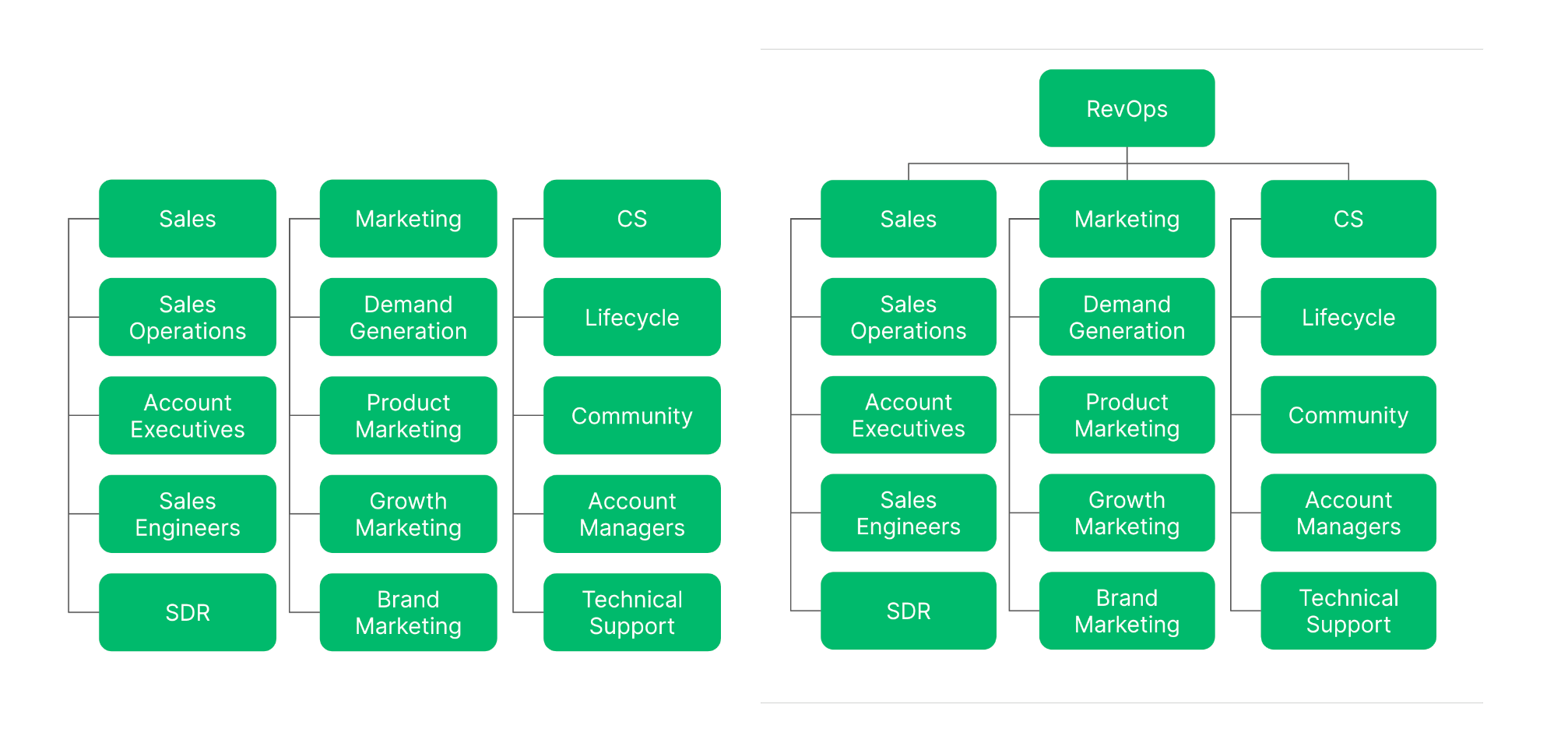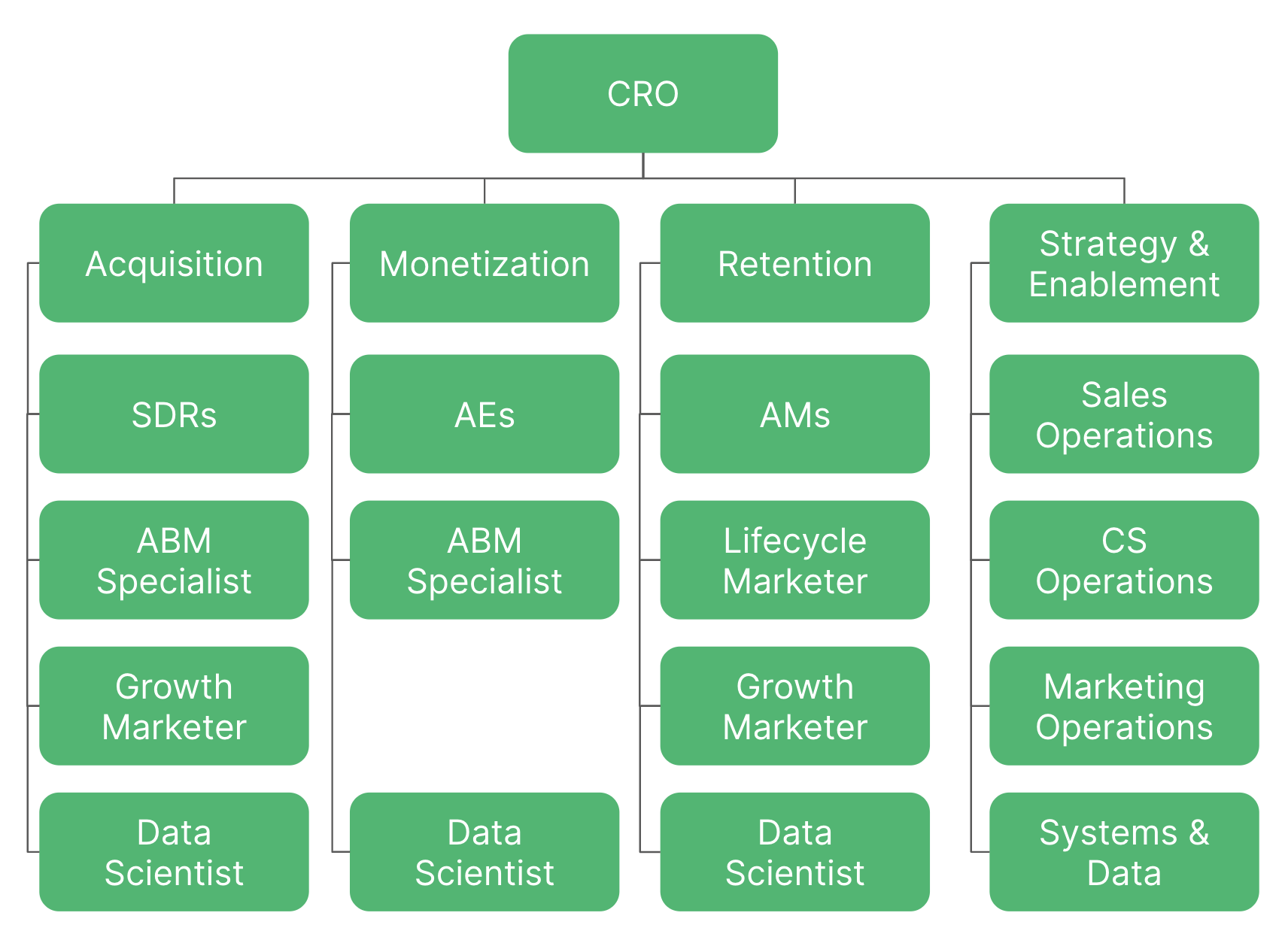A Beginner’s Guide to Revenue Operations (RevOps)
October 21, 2024

Since the beginning of time, there has been a stark tension between marketing, sales, and CS. True believers in RevOps would claim that this is due to the siloed nature of the departments. The purest form of RevOps is when Sales, Marketing, and CS operate as one unit.
What is Revenue Operations?
The goal is to gain operational efficiencies with a single objective in mind. When done right, RevOps will have all processes integrated into one GTM motion where every department helps drive toward a singular revenue goal. The purpose of a RevOps team is to puncture the tension between the three customer-facing teams and create a common goal they can all strive to achieve.
RevOps typically works best at companies with a sales-led growth strategy or organizations with sizeable sales teams. The frequent battles between Sales, Marketing, and CS is normal, and it comes from misaligned teams, and converting to RevOps is a great way to ensure alignment across your revenue teams.
How Most Companies Embed RevOps and Why It’s Wrong
The key that unlocks alignment challenges is hard to find. Most companies that hear of RevOps and think they can take their existing team structure and swing it under a single department often run into trouble. Sales still complain about the lack of MQLs, Marketing still complains about sales failure to close SQLs, and CS complains that the customers you acquire need higher quality.

This needs to be improved. The whole point of RevOps is that you integrate the teams well and ensure that the team runs as a unit rather than three distinct teams. Your goal as a RevOps leader is to identify gaps in your Go-To-Market motion that you can fill with the right resources without bloating your organization. It’s easy to fill an org with 50 new inbound reps, but you will have wasted a lot of resources if they don’t have the leads to sell to.
The classic RevOps structure looks like this:

You have a Chief-Revenue-Officer at the top, and underneath, you have:
- Operations teams for Sales, Marketing, and CS, who improve processes and efficiency.
- A strategy and enablement team to forecast revenue, train, and do strategic planning.
- A Systems and data team who manages the tech and data infrastructure across teams.
This structure gets you some way, and you ensure that the executing teams run in the same direction. This structure will remove a lot of the friction, and you can extend this by setting up a bonus scheme based on team performance rather than individual performance to create a healthy team culture.
There’s a better structure.
The goal of a RevOps team is to break down the silos in each team so that you can go one step deeper. Fully stacked teams handle their part of the sales funnel.

This way, you have a fully stacked RevOps team that can execute quickly without bureaucracy. Add designers, product managers, and engineering resources when necessary for extra speed. There are four components to this setup:
- Acquisition.
- Monetization.
- Retention.
- Strategy & Enablement.
1. Acquisition
The acquisition team ensures the pipeline is filled to the rim with highly qualified leads. Sales and marketing work together on the same team and develop unique solutions to drive more leads.
2. Monetization
Monetization is all about converting to paid. Their job is to build the process that best converts the prospect to a customer. Marketers, sellers, and data scientists collaborate to build the best possible pipeline for their prospects.
3. Retention
This team is about getting the customer fast to value and build experiences that build long-term relationships with your customers. They set up flows that ensure the customer gets the most value from their plan and push them towards expansion.
4. Strategy & Enablement
This team sets the strategy and prepares the metrics that matter for the RevOps team. This department determines revenue targets, pricing, packaging, and sales enablement, and they then work with the customer-facing teams to implement systems and processes that get the team closer to their ideal values. They conduct training on new product releases, content, and processes. This team is vertically integrated into the Revenue team and ensures that all the areas of the revenue team have one singular focus.
The organization design of a RevOps team should always put a heavy emphasis on
- Alignment.
- Streamlining.
- Improvement.
- Growth.
These four elements ensure that your RevOps team is guided toward better execution and value. You’ll want to ensure that learning doesn’t happen in silos. This is where chapters come in.
Chapters Drive Knowledge-sharing Across Teams
Your RevOps org, when designed right, will no longer group departments by skill. Much of the knowledge-sharing that used to come from your like-minded team members is now not achieved through team meetings.
Spotify is one of the leading companies when it comes to agile teams. They introduced a new way to structure teams to ensure that they increased the output per employee. This restructuring meant that knowledge-sharing is now facilitated in a new way.
The music giant ensures that knowledge is shared in four ways:
- Through squads: A team that operates as a mini startup.
- Tribes: A larger team comprising multiple squads who work in related fields.
- Chapters: A horizontal structure where people with similar skills share knowledge.
- Guilds: Communities of people across all tribes who come together to share knowledge.

This is an effective way to foster alignment, autonomy and maintain the knowledge-sharing we are used to with the classic team structure.
This is what chapters would look like when you apply them to the RevOps team.

The fear that the marketing team will no longer have the benefit of the various disciplines they need to succeed isn’t valid. Most marketing teams are already siloed. The different teams work on different projects and often run into blockers due to bureaucracy. Whose project is a higher priority? With fully stacked teams you should be able to accomplish everything with the resources you have available. Chapters help you ensure that all teams learn from each other in an organic way.
What Metrics Does a RevOps Measure?
In short? Revenue. The metrics that matter to a RevOps team all contribute to revenue somehow. The typical metrics you’d look at would be:
- ARR - Annual recurring revenue: How much revenue can we expect within a year.
- CLV - Customer Lifetime Value: How much revenue you on average drive through the lifetime of a customer.
- Win rate: The percentage of prospects you speak to who convert to customers?
- Churn: The percentage of customers who no stop doing business with you.
- CAC - Customer Acquisition Cost: The price you pay to acquire a customer.
These are the core metrics that drive the team, and when there is an anomaly, the team will dive deeper into component-specific metrics. Let’s say churn is up. The retention team will have a clear overview of where there might be issues. The average number of seats is down, the latest pricing launch impacted metrics negatively. Whatever it is they explore options to get the team back on track.
Benefits of RevOps
There are many, but the key reason so many organizations start to think differently about how to structure their revenue teams is that RevOps is a powerful way to rally your teams around one agenda: Revenue.
- Team alignment: RevOps aligns the objectives, processes, and data of sales, marketing, and customer success teams, which helps the teams work on the same revenue goals.
- Efficiency: RevOps improves operational efficiency as it streamlines workflows, removes unnecessary tasks, and automates repetitive activities.
- Decision making: Because RevOps has a holistic view of the business, it’s able to provide accurate insights. It makes decisions faster to make and more informed.
- Great customer experiences: The extreme alignment and coordination between teams, make the customer journey smoother, which helps with satisfaction and loyalty.
- Revenue: The obsessive focus on metrics that drive revenue makes it easy to identify opportunities to upsell, cross-sell, reduce churn, or increase the customer lifetime value.
- Scalability: RevOps establishes processes and systems that scale. This is great when you reach the next stage of your growth where you might not keep up in a classic setup.
- Predictable: RevOps makes business more predictable with a high focus on revenue forecasts. It also helps reduce the variability in performance across different teams.
- Improvement culture: The data-driven nature of RevOps fosters a culture of continuous improvement. Regular performance reviews ensure that all teams learn daily.
- Communication: RevOps leads to improved communication and collaboration, as it requires cross-departmental meetings and coordination with stakeholders who matter.
Revenue operations may not be for everyone, but the underlying concepts that promote alignment, communication, and collaboration are worth trying. We are big fans of RevOps at Grain and we spent a great deal of time fostering a culture of continuous improvement. We often explore new concepts that will give us a closer connection with our customers.